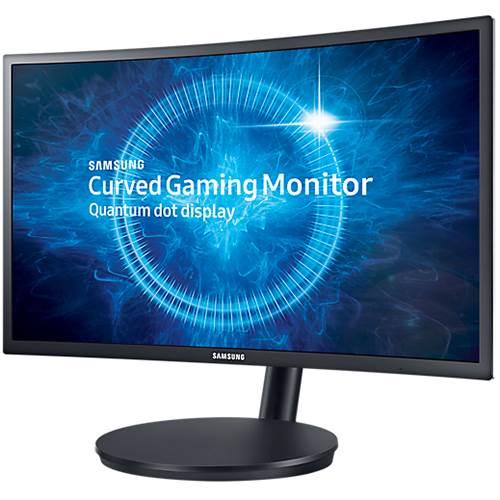There are many great monitors for gaming and selecting from them can seem quite difficult especially when you are considering important things like refresh rates, display resolutions, response times, and even connections like HDMI and DisplayPort. Now there’s another thing to consider – a curved monitor. The success of curved televisions makes curved monitors enticing for gamers, but most rightly ask the following question: why should I upgrade to a curved monitor?
Some may see a curved monitor as nothing more than a TV for gaming, but that is oversimplifying how these devices work. Curved monitors look cool, but they also perform some interesting functions, especially when you consider how gaming is trending more towards VR these days.
When you have a chance to review curved monitors, be sure to take a look at the important parts of the monitor’s functionality. Don’t choose a curved monitor that has lower response time than a flat screen simply because the curved monitor looks cooler. This is a great way to not enjoy what should be an enjoyable purchase. All things being equal, there are some very specific advantages and disadvantages to choosing a curved monitor over a flat screen.
Why You Will Like a Curved Monitor

Curved monitors provide a lot of benefits to gamers. In this section, you’ll see the things that gamers really love about a curved monitor and why, when all things are equal, they choose a curved monitor over a flat monitor.
Depth: The curve is responsible for producing images that look three dimensional. Though you are not having a truly 3D experience, gaming on a curved monitor is closer to being 3D than it is on a flat screen thanks to the depth provided by the monitor. While you may not notice this initially, when you get used to playing on a curved monitor and go to a flat screen, the images will not feel as fully developed.
Viewing Angle: A flat screen viewing angle does not have the same high level of color saturation and contrast the way a curved monitor would have. The screen’s curvature actually accommodates the distortion present in the projection necessary to create images on a screen. You get a wider viewing angle thanks to the curvature, but there comes a point when the viewing angle on a curved monitor becomes a drawback compared to a flat monitor, so be aware of this.
Reflection Reduction: Hate dealing with the glare on a flat monitor? We all do. Curved monitors do a better job of negating the stray light problems that occur on flat monitors. If you’re in a room with a window in the wrong place or a mirror that refracts light at a certain point of the day, you know the problems here. The curved monitor makes it so the glare doesn’t create problems because the light won’t be sent back into your face. Or you play any casinos listed here then these curved monitors are the best for you.
Immersion: In the real world, nothing is flat, and everything has angles. The curvature intends to make sure that your peripheral vision is engaged which provides an experience that feels more like real life. This immersive nature makes the gamer feel like they are right in the middle of the action instead of being an external manipulator of what’s going on.
Design: Now, granted, we shouldn’t choose something because it looks cool, but all things being equal, a curved monitor is cooler than a flat screen monitor. Remember when the flat screen replaced the tube television? This is the same idea. Advances in technology look amazing, and if nothing else it makes your gaming setup look that much more impressive.
Why You Won’t Like the Curved Monitor
Viewing Angle: Ok, it seems like the angle is a positive but there are limitations. Developers believe the curved screen will restrict your range for viewing near 35 degrees. The corners of the screen – especially if you’re directly in front of it – will look odd so it is imperative to find the right viewing angle for everything to look proper.
Wall Mounting: Let’s say you’re a gamer with limited space, wall hanging is a great way to save some space on the desk. Curved monitors don’t mount to the wall quite right and look odd if you do mount them. Also, many curved monitor manufacturers don’t make wall mounts, so you’d be relying on third party parts. This is not ideal when spending a few hundred on a sweet curved monitor.
Distortion: One of the issues that some have with curved monitors is best described as a “bow-tie.” That is to say, the image is wide at the edges and narrow in the middle. That said, there are some folks who don’t notice it while other folks can’t help but notice. The geometry of the curved screen certainly makes this effect real, so like the viewing angle, you will need to spend some time to find the right viewing angle to negate this effect.
Expense: As a rule, curved monitors are more expensive than flat monitors because they require more specialized construction. A flat monitor with the same technical specs as a curved monitor will be less expensive because it is not as difficult to produce. This is something that could definitely influence the decision.
Conclusion
So now that we have explored the advantages and disadvantages of the curved monitor, the next question is should you go out and buy one. Remember the premise – the choice between a curved and flat monitor is dependent on all other specifications being equal. There are plenty of advantages to a curved monitor, and perhaps the feeling of being “in” the game is something you’ll enjoy. That said, if you mind having to find the right angle, then a curved monitor may not be right for you.
The truth is this comes down to personal preference. There are some great advantages to curved monitors and gamers do report enjoying this style of monitor. With the emerging nature of VR, curved monitors will most likely become more sophisticated and provide greater benefits. If you can afford a curved monitor, then go for it. It’s a great way to bring a new experience to your gaming.



